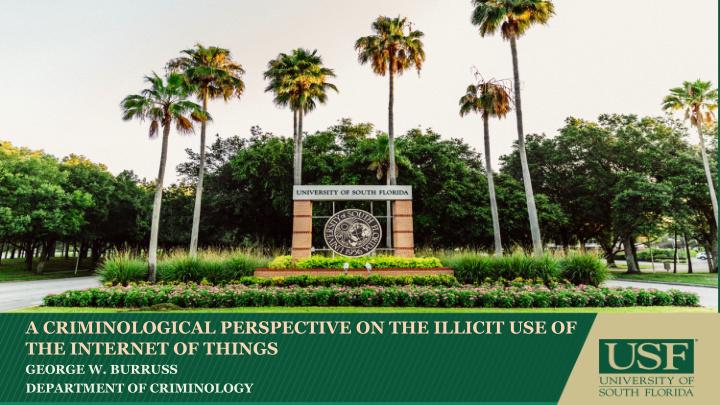



A CRIMINOLOGICAL PERSPECTIVE ON THE ILLICIT USE OF THE INTERNET OF THINGS GEORGE W. BURRUSS DEPARTMENT OF CRIMINOLOGY
Why would a criminologist be interested in IoT? • IoT used as a vector for hacking, causing harm: –Expose user data –Privacy violations/surveillance –Denial of service attacks • Hackers using IoT likely involved in other illegal activities
Areas of interest to a criminologist regarding IoT • Offender motivations • Victims’ routine activities • Criminal opportunity structure • Legal response (laws & regulations) • Law enforcement (Cybersecurity) response
Offender Motivations and IoT • Techniques of Neutralizations –Deny the victim –Denial of injury • Subcultural theory –Hacker norms and expectations • Social Learning –Define use of IoT for crime as normative –Imitation and reinforcement • Rational Choice and Deterrence
Offender Motivations and IoT • Techniques of Neutralizations –Deny the victim –Denial of injury • Subcultural theory –Hacker norms and expectations • Social Learning –Define use of IoT for crime as normative –Imitation and reinforcement • Rational Choice and Deterrence
Offender Motivations and IoT • Techniques of Neutralizations –Deny the victim –Denial of injury • Subcultural theory –Hacker norms and expectations • Social Learning –Define use of IoT for crime as normative –Imitation and reinforcement • Rational Choice and Deterrence
Offender Motivations and IoT • Techniques of Neutralizations –Deny the victim –Denial of injury • Subcultural theory –Hacker norms and expectations • Social Learning –Define use of IoT for crime as normative –Imitation and reinforcement • Rational Choice and Deterrence
Offender Motivations and IoT • Techniques of Neutralizations –Deny the victim –Denial of injury • Subcultural theory –Hacker norms and expectations • Social Learning –Define use of IoT for crime as normative –Imitation and reinforcement • Rational Choice and Deterrence
Victim’s online activities expose them to offenders • Routine activities theory explores how daily patterns increase likelihood of victimization • We can examine the self-protective actions people take and why? Suitable Target Lack of Guardianship Motivated Offender
Victim’s online activities expose them to offenders • Routine activities theory explores how daily patterns increase likelihood of victimization WWW • We can examine the self-protective actions people take and why? Password1!
The legal, law enforcement, and cybersecurity response • Criminologists examine the impact of laws and regulations on behavior • Examine how criminal justice agencies respond (or not) to cybercrime • Need to understand how cybersecurity fits within traditional response to criminal behavior
Criminologists study cybercrime through various methods • Quantitative Analysis of available usage data • Surveys of users, victims, and offenders • Qualitative interviews of victims and offenders • Natural experiments on policies and practices
In sum: • IoT is but one aspect of cybercrime and cybersecurity that presents an opportunity to study deviant and harmful online behaviors. • Criminologist would benefit for partnering with computer scientists and other technology experts to help develop theories and empirical studies of online behavior.
Recommend
More recommend